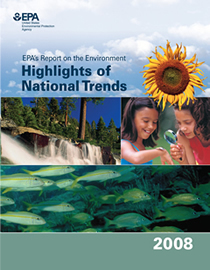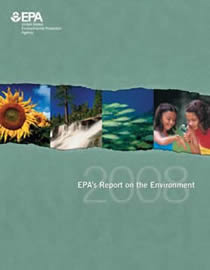The Report on the Environment (ROE) is a project that asks important questions about trends in our nation’s environment over time. The ROE is composed of two reports – the "2008 Report on the Environment," a technical document intended for environmental professionals, and the "2008 Report on the Environment: Highlights of National Trends," (PDF, 40 pp, 2.9 Mb, About PDF) (sometimes referred to as the ROE Highlights Document) which summarizes the key findings of the technical document without all of the technical detail. The ROE presents the best available, scientifically sound information on national environmental and human health trends critical to EPA's mission and of interest to the public.
This electronic presentation (also referred to as eROE) provides access to all the environmental trend data contained in both reports in one location and in a searchable format. This Web site also provides access to the methodology, references, and sources of additional information behind the indicators that form the foundation of the reports. The navigational graphic below is an integration of both the technical and highlight reports that gives you several options for accessing content (e.g., chapter tabs, pdfs, or dynamic Web sites).


Report on the Environment
- ROE Dynamic Web Site
Click into the details of the EPA's 2008 ROE - chapter text and individual indicators. - EPA's 2008 Report on the Environment
Highlights of National Trends
- ROE Highlights Dynamic Web site
Click into the details of the EPA's ROE Highlights Document - for overviews and key points.
- EPA's 2008 Report on the Environment: Highlights of National Trends (PDF, 40 pp, 2.9 Mb, About PDF)
Overview
To accomplish its mission, the U.S. Environmental Protection Agency (EPA) must pay close attention to trends in the condition of the nation’s air, water, and land, and to associated trends in human exposure and health and the condition of ecological systems.
- They provide valuable input to EPA in developing its strategic outlook and priorities, and
- they allow EPA and the public to assess whether the Agency is succeeding in its overall mission to protect human health and the environment.
EPA prepared this Report on the Environment (ROE) to accomplish these purposes.
Learn more under Basic Information.
Report Breakout
The ROE is comprised of two products:
- The ROE presents indicators that help to answer questions of importance to EPA’s mission. It also discuss important limitations of these indicators and gaps where adequate indicators are not available.
- The ROE Highlights of National Trends document (ROE-HD) is a short publication that describes national environmental trends for the general public. It summarizes key points from the ROE.
Report Format
Both reports (the ROE and the ROE-HD) are presented with five chapters specifically addressing: Air, Water, Land, Human Health, and Ecological Condition.
Learn more under Frequent Questions.
Outdoor Air

Q. What are the trends in outdoor air quality and their effects on human health and the environment?
A. This question examines a broad spectrum of outdoor air quality issues, including polluted air that people breathe at ground level, deposition of air pollutants to land and water, and depletion of the Earth's ozone layer. For each issue, information is provided both on the main stressors (emissions sources) and potential health and environmental effects.
Greenhouse Gases

Q. What are the trends in greenhouse gas emissions and concentrations?
A. This question focuses on releases and atmospheric concentrations of certain so-called "greenhouse gases," or gases in the atmosphere that help regulate the Earth's temperature and thus contribute to climate change - a topic introduced in this (Air) chapter and revisited in the chapter on "Ecological Condition."
Indoor Air Quality

Q. What are the trends in indoor air quality and their effects on human health?
A. This question considers air quality in indoor settings, such as homes, offices, and schools, and how poor indoor air quality can affect human health and welfare, whether by causing adverse health effects or by impairing productivity.
Fresh Waters

Q. What are the trends in extent and condition of fresh surface waters and their effects on human health and the environment?
A. This question focuses on the nation's rivers, streams, lakes, ponds, and reservoirs.
Ground Water

Q. What are the trends in extent and condition of ground water and their effects on human health and the environment?
A. This question addresses subsurface water that occurs beneath the water table in fully saturated soils and geological formations.
Wetlands

Q. What are the trends in the extent and condition of wetlands and their effects on human health and the environment?
A. This question addresses wetlands -including swamps, bogs, marshes, and similar areas- as areas inundated or saturated by surface or ground water often and long enough to support a prevalence of vegetation typically adapted for life in saturated soil conditions.
Coastal Waters

Q. What are the trends in extent and condition of coastal waters and their effects on human health and the environment?
A. This question includes indicators for waters that are generally within 3 miles of the U.S. coastline (except the Hypoxia in Gulf of Mexico and Long Island Sound indicators).
Drinking Waters

Q. What are the trends in the condition of drinking water and their effects on human health?
A. This question addresses the condition of drinking water. People drink tap water, which comes from both public and private sources, and bottled water. Sources of drinking water can include both surface water (rivers, lakes, and reservoirs) and ground water.
Recreational
Waters

Q. What are the trends in the condition of recreational waters and their effects on human health and the environment?
A. This question addresses water used for a wide variety of purposes, such as swimming, fishing, and boating.
Consumable Fish
and Shellfish

Q. What are the trends in the condition of consumable fish and shellfish and their effects on human health?
A. This question focuses on the suitability of fish and shellfish for human consumption.
Land Cover

Q. What are the trends in land cover and their effects on human health and the environment?
A. This question refers to the actual or physical presence of vegetation or other materials (e.g., rock, snow, buildings) on the surface of the land (whcih differs from land use-see the next question).This is important from the perspective of understanding of land as a resource and its ability to support humans and other species. Changes in land cover can affect other media (e.g., air and water).
Land Use

Q. What are the trends in land use and their effects on human health and the environment?
A. This question refers to the economic and cultural activities practiced by humans on land. Land use can have effects on both human health and the environment, particularly as land is urbanized or used for agricultural purposes.
Wastes

Q. What are the trends in wastes and their effects on human health and the environment?
A. This question refers to the numerous types of waste generated as part of most human activities. Trends in waste include trends in types and quantities of, and mechanisms for, managing wastes. Waste trends reflect the efficiency of use and reuse of materials and resources and potential for land contamination.
Chemicals

Q. What are the trends in chemicals used on the land and their effects on human health and the environment?(Chemicals to include toxic substances, pesticides, fertilizers, etc.)
A. This question refers to the various chemicals produced or used on land for many purposes. The quantity and diversity of chemicals and the potential for interactions among them have created challenges in understanding the full effects of their use. Pesticides, fertilizers, and toxic chemicals are examples of chemicals applied or released on land.
Contaminated Land

Q. What are the trends in contaminated land and their effects on human health and the environment?
A. This question refers to contaminated lands, which are those lands that have been affected by human activities or natural events such as manufacturing, mining, waste disposal, volcanoes, or floods that pose a concern to human health or the environment. The worst-contaminated lands are tracked and their cleanups overseen by EPA.
Human Exposure

Q. What are the trends in human exposure to environmental contaminants, including across population subgroups and geographic regions?
A. This question refers to data on trends in exposure levels provide an opportunity to evaluate the extent to which environmental contaminants are present in human tissue, independent of the occurrence of specific diseases or conditions. To address this question, this chapter focuses on biomonitoring indicators (or biomarkers of exposure) for environmental contaminants such as lead, mercury, and pesticides.
Health Status

Q. What are the trends in health status in the United States?
A. This question uses several general health outcome indicators (life expectancy, infant mortality, and general mortality) to provide a broad picture of health in the U.S. Trends in these indicators provide a general context for understanding trends in specific diseases and conditions that may in part be linked with the environment.
Human Disease and Conditions

Q. What are the trends in human disease and conditions for which environmental contaminants may be a risk factor, including across population subgroups and geographic regions?
A. This question looks at the occurrence of diseases and conditions that are known or suspected to be caused (to some degree) or exacerbated by exposures to environmental contaminants. This chapter uses a spectrum of indicators for health outcomes-such as cancer, asthma, and birth outcomes-to address this question. Both morbidity and mortality statistics are considered.
Patterns in Ecological Systems

Q. What are the trends in the extent and distribution of the nation's ecological systems?
A. This question examines trends in the overall extent (e.g., area and location) of different kinds of ecological systems (e.g. forests, undeveloped lands, and watersheds) and of spatial patterns in the distribution of ecological systems that affect interactions of nutrients, energy, and organisms.
Biological Diversity

Q. What are the trends in the diversity and biological balance of the nation's ecological systems?
A. This question explores trends in the types and numbers of species that live within ecological systems. The question also examines biological balance in terms of the proportional distributions of species and the influence of interactions among native and invasive species on the stability of ecological systems.
Ecological Processes

Q. What are the trends in the ecological processes that sustain the nation's ecological systems?
A. This question focuses on trends in the critical processes that sustain ecological systems, such as primary and secondary productivity, nutrient cycling, decomposition, and reproduction.
Attributes of Ecological Systems

Q. What are the trends in the critical physical and chemical attributes of the nation's ecological systems?
A. This question addresses trends in the physical and chemical attributes of ecological systems. Physical attributes can include climatological patterns, hydrology, and electromagnetic radiation, as well as major physical events that reshape ecological systems, such as fires, floods, and windstorms. This question also examines chemical attributes such as pH, oxidation-reduction potential, and nutrient levels.
Exposure to Contaminants

Q. What are the trends in biomarkers of exposure to common environmental contaminants in plants and animals?
A. This question examines trends in biomarkers of exposure to contaminants that are particularly important to the health of plants and animals as well as to humans who consume such organisms.
![[logo] US EPA](https://webarchive.library.unt.edu/eot2008/20090507221057im_/http://www.epa.gov/epafiles/images/logo_epaseal.gif)